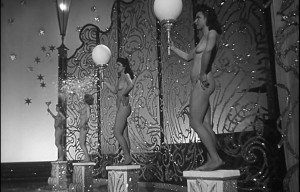vt The Last One of the Six
France / 89 minutes / bw / Teledis, L’Union Générale Cinématographique, Citadel Dir: Georges Lacombe Scr: Georges Clouzot (i.e., Henri-Georges Clouzot) Story: Six Hommes Morts (1930) by S.A. Steeman Cine: Robert Lefebvre Cast: Pierre Fresnay, Michèle Alfa, Suzy Delair, Jean Tissier, Jean Chevrier, Lucien Nat, André Luguet, Georges Rollin, Raymond Segard, Paul Demange, Odette Barencey.
A far better remake of The Riverside Murder (1935).
Five years ago six broke friends—Jean Perlonjour (Chevrier), Henri Senterre (Luguet), Georges “Jo” Gribbe (Rollin), Marcel Gernicot (Nat), Tignol (Tissier) and Namotte (Segard)—pooled what little money they had and sent Perlonjour to gamble with it. He returned having won triumphantly, and the sextet agreed to split the money six ways and each go out into the world to seek their fortune, reuniting in five years to share their wealth.
Now the impoverished Perlonjour returns to Paris, where Senterre has become a wealthy nightclub impresario; they discover that Namotte has apparently been murdered by being thrown from L’Aquitaine en route from Dakar to France. Another arrival is Gernicot, who seems twitchy and uneasy; his unloving wife, professional markswoman Lolita (Alfa), proves to be an old flame of Perlonjour’s. Gribbe has been in Paris all the while, forging cheques and betting on the ponies; Tignol was in Rouen, where he married a rich widow.
Gernicot is shot in Senterre’s luxury apartment; by the time Senterre returns with help, the corpse has disappeared. The plot really centers on the mystery of how this disappearance was effected. When Tignol’s murdered in Senterre’s nightclub during Lolita’s premiere performance there and then Gribbe is found dead in a fleapit Paris hotel, it’s obvious to all—and especially Commissaire Wenceslas “Wens” Vorobotchik (Fresnay)—that one of the quasi-tontine is murdering the others. The solution to the mystery—the identity of the killer—is obvious in hindsight, less so while you’re actually watching the movie.
It would be hard to claim this as a full-scale noir—there’s too much humor, notably from Wens’s chanteuse mistress Mila Malou (Delair) but also elsewhere—but it certainly has borderline noir status. Since it was made at a time when the French had no access to the crime movies being created in the US—those movies that would become regarded as the core works of film noir—we can hardly claim it was influenced by them; had it been made ten years later, on the other hand, we’d have been pontificating about its being derivative of the US school.
Aside from its stylishness, there are some obvious differences, especially in terms of its attitude toward sex: There’s no opprobrium attached to the fact that Wens and Mila are living together (in a US movie of the time, there’d likely be a conscious focus on the arrangement’s sordidness, assuming it weren’t just written out of the script) and, when Mila talks about a friend of hers who slept with every fireman in a firehouse, her horror is not at the promiscuity but that the friend should sink so low as to sleep with firemen. Again, part of Lolita’s shooting act at Santerre’s decadent nightclub The Palladium is to burst globes that are being held aloft by nude women, little of whose nudity is hidden from the camera; even though the scene is charming and satirically witty rather than salacious, the upholders of the Production Code would have had a fit. Just compare this with the markswoman act of Annie Laurie Starr (Peggy Cummins) in GUN CRAZY (1949), which the US thought was rather saucy.
A scene you’d not find in Gun Crazy (1949).
Clouzot would bring back the characters of Wens and Mila in his directorial debut, L’ASSASSIN HABITE AU 21 (1942; vt The Murderer Lives at Number 21), again based on a Steeman novel. Both movies, and others involving Clouzot as either writer or director (or both), were done for the Nazi-financed company Continental, a circumstance that was to cause him some trouble after WWII was over.
Reportedly Lacombe declined to direct the protracted Busby Berkeley-style nightclub act himself.
On Amazon.fr: Le Dernier de Six

Pingback: Riverside Murder, The (1935) | Noirish